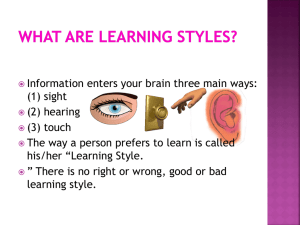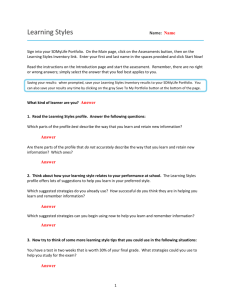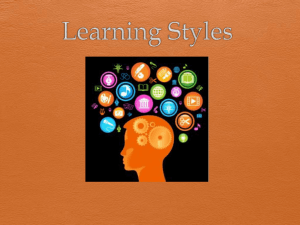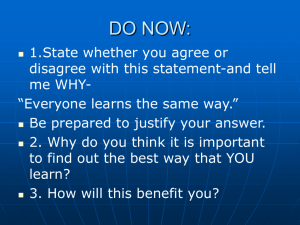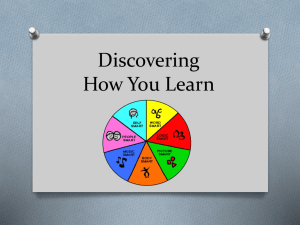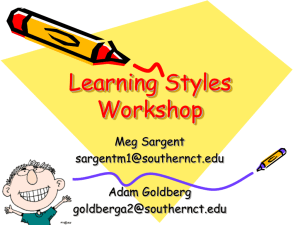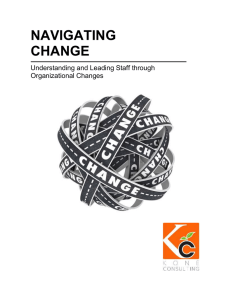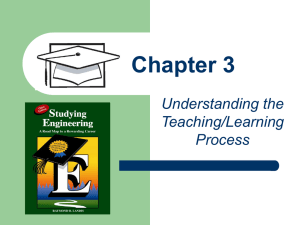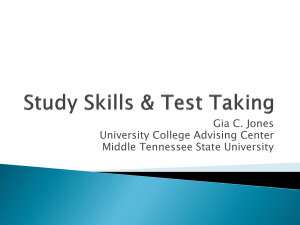Learning Styles
advertisement
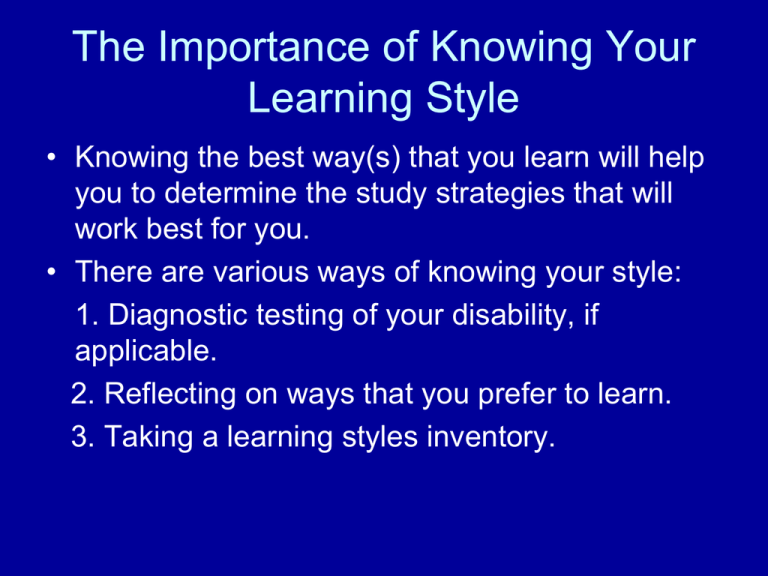
The Importance of Knowing Your Learning Style • Knowing the best way(s) that you learn will help you to determine the study strategies that will work best for you. • There are various ways of knowing your style: 1. Diagnostic testing of your disability, if applicable. 2. Reflecting on ways that you prefer to learn. 3. Taking a learning styles inventory. Learning Styles *Auditory vs. Visual Learners Auditory - learn better through hearing information. Visual - learn better through seeing information (in print, video, demonstration, etc.) *Applied vs. Conceptual Learners Applied - learn better with practical, real world examples. Conceptual - do not need these examples to understand, they prefer to work with abstract language or ideas. *Spatial vs. Verbal Learners Spatial learners are very visual, able to visualize how something should look or fit together. Verbal learners are more language-oriented and find visualizing difficult. Learning Styles (cont.) *Social vs. Independent Learners Social – prefer to work with others, including TAs Independent – prefer to work alone *Creative vs. Pragmatic Learners Creative – imaginative, think “outside of the box” Pragmatic – logical, prefer order and rules These learning styles are listed in College Reading and Study Skills, Kathleen McWhorter,8th ed., 2001 Learning Strategies Based on Auditory Learning Style • Auditory learners learn best from lecture and discussion with others. Consider meeting with a professor, TA or tutor on a regular basis to go over course content. • Start a study group with one or more of your peers to discuss course content and review material together. • While studying, try saying the material out loud. This may help you to remember the information better. Learning Strategies Based on Visual Learning Style • Visual learners learn best from visually presented materials such as pictures, charts and graphs. Be sure to focus on these when reading. • Draw pictures and diagrams in your notes, where appropriate. • Utilize mapping techniques when reading, preparing to write a paper or studying for an exam. A software program that uses mapping is called Inspiration. It is available for a 30 day download from www.inspiration.com. Learning Strategies Based on Applied Learning Style • When studying, try to come up with at least one example of every concept/topic studied. • Apply the material you are learning to practical situations or your own previous knowledge/experience when possible. • Be sure to pay attention to case study examples when reading. Learning Strategies Based on Conceptual Learning Style • Note the “overall picture” or concept as you are reading – take notes on these. • Organize material from the general to the specific. Note concepts and examples of these concepts. Learning Strategies Based on Spatial Learning Style • This learning style is closely connected to the visual learning style. • Draw diagrams or pictures. • Organize information into charts or flow diagrams. • See visual learning style slide for more strategies. Learning Strategies Based on Verbal Learning Style • This learning style is closely connected to the auditory learning style. • Write key words to describe the steps of processes and procedures. • Write key words to label parts of a visual diagram or picture. Learning Strategies Based on Social Learning Style • Find others to study with: partner, group. • Meet with the instructor or TA on a regular basis to review course concepts. • Be sure to participate in class discussion! Learning Strategies Based on Creative Learning Style • Courses that are not overly structured but allow students to explore or experiment with the course content may be best for you. • Note your reactions to course content. This could be used in class discussion or on a paper. Learning Strategies Based on Independent Learning Style • Traditional lecture courses or independent study courses may work best for you. • As needed, use alternative books or other resources to help you understand the course content. Learning Strategies Based on Pragmatic Learning Style • Write lists of steps • Follow a rubric (guidelines) when you study or write a paper. If a rubric is not given to you, consult with the professor so you know how you will study or what to focus on when you write your paper. • Focus on organizing the course information in a logical sequence such as: cause and effect or problem-solution. Learning Styles How you learn best For more indepth information about your learning style, take the online learning style inventory, listed below. It gives immediate feedback. Learning Styles: http://www.metamath.com/lsweb/dvclearn.htm
